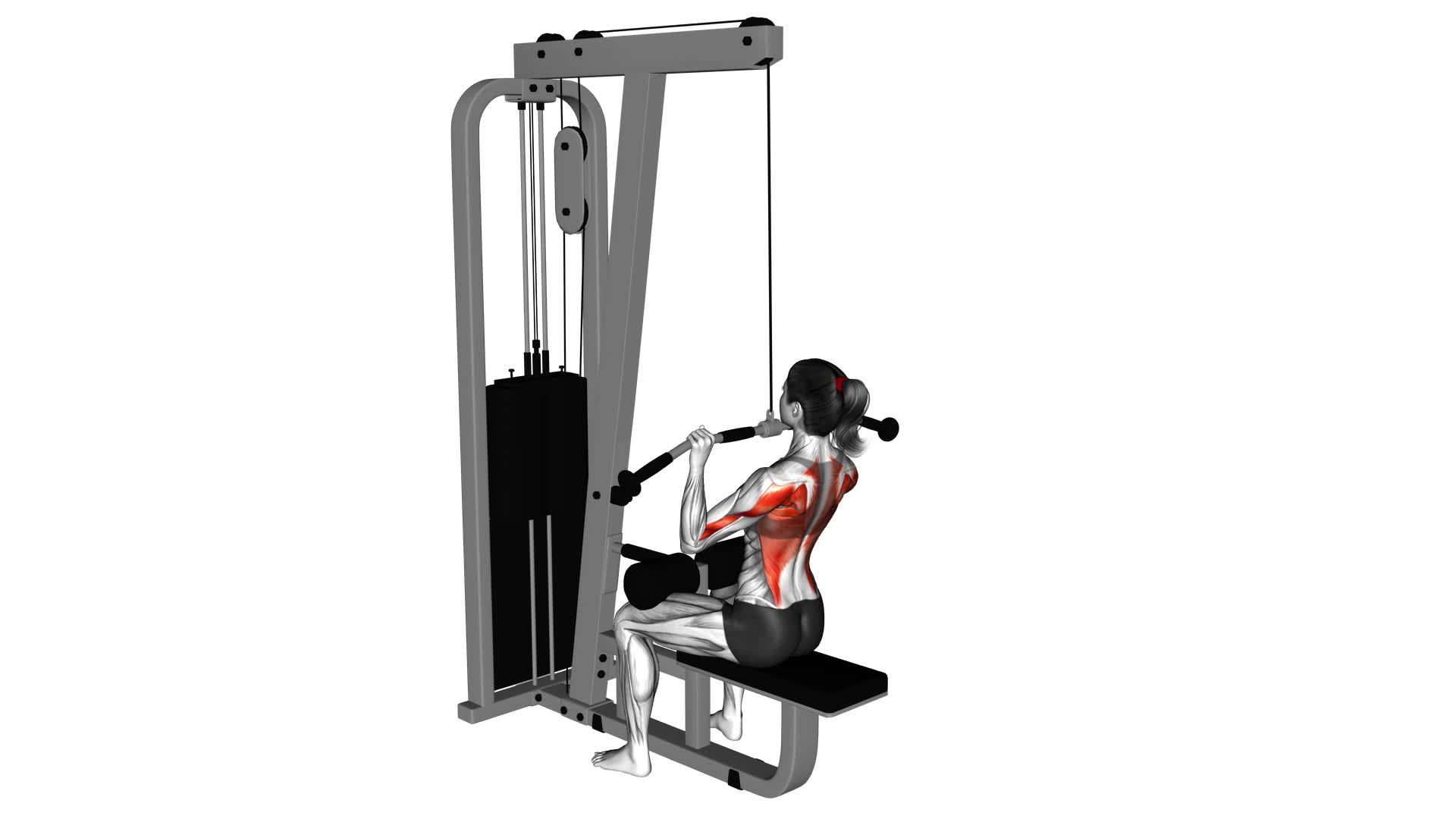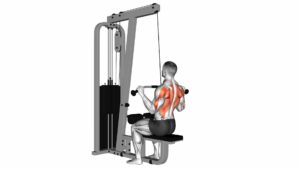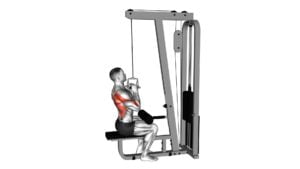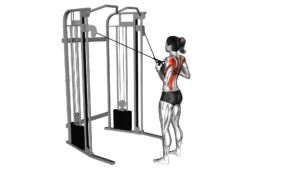Cable Bar Lateral Pulldown (female) – Video Exercise Guide & Tips

Get ready to strengthen and tone your back with the Cable Bar Lateral Pulldown.
Watch This Exercise Video
This exercise is perfect for women looking to build upper body strength and improve posture.
In this video guide, we'll show you the proper form and technique, as well as variations for different fitness levels.
Avoid common mistakes and maximize the effectiveness of the exercise with our helpful tips.
Get ready to feel the burn and achieve your fitness goals.
Let's get started!
Key Takeaways
- Targets the latissimus dorsi muscles (lats), improving posture and upper body stability
- Enhances overall strength and power in upper body exercises
- Provides constant tension and reduces the risk of injury
- Can be modified to suit individual fitness levels
Benefits of the Cable Bar Lateral Pulldown
Start by understanding the three key benefits of the Cable Bar Lateral Pulldown exercise. This exercise offers numerous benefits for your upper body strength and overall fitness.
Firstly, one of the main benefits of the Cable Bar Lateral Pulldown is that it targets your latissimus dorsi muscles, commonly known as the lats. These muscles are responsible for pulling movements, and by strengthening them, you can improve your posture and upper body stability. Additionally, stronger lats can enhance your overall strength and power in various upper body exercises.
Secondly, the Cable Bar Lateral Pulldown exercise allows for variations in grip width, which can target different muscles within your back. A wide grip focuses more on the outer portion of your lats, while a narrow grip targets the inner portion. By utilizing these variations, you can effectively work all areas of your back and achieve a balanced and defined physique.
Lastly, the Cable Bar Lateral Pulldown is a safe and controlled exercise that can be easily modified to suit individual fitness levels. The cable machine provides constant tension throughout the movement, reducing the risk of injury and allowing for proper muscle engagement. Additionally, you can adjust the weight and resistance to challenge yourself or gradually increase intensity as you progress.
Proper Form and Technique for the Exercise
To perform the Cable Bar Lateral Pulldown exercise with proper form and technique, it's important to focus on your posture and engage your back muscles throughout the movement. Here are some key points to keep in mind:
- Stand facing the cable machine with your feet shoulder-width apart and knees slightly bent.
- Grasp the cable bar with an overhand grip, hands slightly wider than shoulder-width apart.
- Keep your chest up and shoulder blades down and back, maintaining a slight arch in your lower back.
Begin the exercise by pulling the cable bar down towards your chest in a controlled manner, squeezing your shoulder blades together.
Slowly return the bar to the starting position, fully extending your arms without locking your elbows.
Avoid using momentum or excessive swinging of the body.
Common misconceptions: Many people mistakenly believe that using heavy weights is the key to success in this exercise. However, using proper form and engaging the back muscles is more important than the amount of weight lifted.
Alternative exercises: If you don't have access to a cable machine, you can perform bent-over rows or seated rows using dumbbells or resistance bands.
Variations and Modifications for Different Fitness Levels
To adapt the Cable Bar Lateral Pulldown exercise for different fitness levels, you can adjust the weight resistance or modify the grip position.
For those looking for progression options, increasing the weight resistance can provide a greater challenge to your muscles and help you build strength. Start by gradually increasing the weight in small increments to avoid straining your muscles.
On the other hand, if you're just starting out or have a lower fitness level, you can decrease the weight resistance to make the exercise more manageable. This allows you to focus on proper form and technique before progressing to heavier weights.
Additionally, modifying the grip position can also provide variations in the exercise. Instead of using a wide grip, you can try a narrow grip to target different muscles in your back.
Equipment alternatives for the Cable Bar Lateral Pulldown exercise include using resistance bands or a pull-up bar if you don't have access to a cable machine.
By modifying the weight resistance and grip position, you can customize the exercise to suit your fitness level and goals.
Now that you know how to adapt the Cable Bar Lateral Pulldown exercise for different fitness levels, let's move on to the next section and discuss common mistakes to avoid.
Common Mistakes to Avoid
To avoid common mistakes and maximize the effectiveness of the Cable Bar Lateral Pulldown exercise, ensure that you maintain proper form and engage the targeted muscles throughout the entire movement. Here are some common mistakes to avoid and tips to help you maintain proper technique:
- Using too much weight: Using excessive weight can compromise your form and lead to ineffective results. Start with a lighter weight and gradually increase as you build strength.
- Pulling with your arms: The Cable Bar Lateral Pulldown primarily targets your back muscles, so it's important to initiate the movement from your back, not your arms. Focus on squeezing your shoulder blades together as you pull the bar down.
- Arching your back: Avoid arching your back excessively during the exercise. Keep your core engaged and maintain a slight natural curve in your lower back.
- Rushing the movement: Take your time and perform the exercise with controlled and deliberate movements. Rushing can lead to poor form and reduce the effectiveness of the exercise.
- Neglecting the full range of motion: Make sure to fully extend your arms at the top and squeeze your back muscles before slowly returning to the starting position. This ensures that you engage the targeted muscles throughout the entire movement.
Tips for Maximizing the Effectiveness of the Exercise
To maximize the effectiveness of the Cable Bar Lateral Pulldown exercise, follow these tips.
- Ensure that you have the correct form and technique. Start by sitting down on the pulldown machine with your feet flat on the floor. Grab the cable bar with an overhand grip, slightly wider than shoulder-width apart. Keep your back straight and your chest lifted throughout the exercise.
- Engage your core and pull the bar down towards your chest, focusing on squeezing your shoulder blades together. Avoid using momentum or relying on your biceps to do the work. Instead, use your back muscles to initiate the movement and control the weight.
- Vary your grip width to target different muscles in your back. A wider grip will target the outer muscles, while a narrower grip will emphasize the inner muscles.
- Make sure to use a weight that challenges you but still allows you to maintain proper form. It's better to start with a lighter weight and gradually increase as you get stronger, rather than using too heavy of a weight and sacrificing form.
Sample Workout Routine Incorporating the Cable Bar Lateral Pulldown
Now let's incorporate the Cable Bar Lateral Pulldown into a sample workout routine to further enhance your back muscles. Here's a full body workout routine that includes the Cable Bar Lateral Pulldown:
- Warm-up:
- Start with 5-10 minutes of light cardio to get your blood flowing.
- Perform some dynamic stretches targeting your upper body, focusing on your shoulders, chest, and back.
- Strength training:
- Begin with compound exercises like squats or deadlifts to engage multiple muscle groups.
- Follow with the Cable Bar Lateral Pulldown, aiming for 3 sets of 8-12 repetitions.
- Alternate between upper and lower body exercises to allow for recovery.
- Cardiovascular exercise:
- Incorporate 20-30 minutes of moderate to high-intensity cardio, such as running or cycling, to elevate your heart rate and burn calories.
- Additional exercises:
- Include other back exercises like bent-over rows or pull-ups to target different areas of your back.
- If you prefer alternatives to the Cable Bar Lateral Pulldown, try exercises like seated cable rows or lat pulldowns using a wide grip.
- Cool-down:
- Finish your workout with 5-10 minutes of light cardio and static stretches to help your muscles recover and prevent stiffness.
Frequently Asked Questions
How Many Sets and Reps Should I Do for the Cable Bar Lateral Pulldown?
To determine the number of sets and reps for the cable bar lateral pulldown, it's important to focus on proper form and technique. Start with a weight that challenges you but allows you to maintain good form throughout the exercise.
Aim for 3-4 sets of 8-12 reps, resting for about 30-60 seconds between sets.
Can the Cable Bar Lateral Pulldown Help With Improving Posture?
The cable bar lateral pulldown is a great exercise for improving posture. By targeting the muscles in your back and shoulders, it can help strengthen and stabilize your upper body.
The benefits of this exercise include improved alignment, reduced risk of slouching, and increased overall strength. Incorporating the cable bar lateral pulldown into your workout routine regularly can make a noticeable difference in your posture and overall body alignment.
Is the Cable Bar Lateral Pulldown Suitable for Individuals With Shoulder Injuries?
If you have a shoulder injury, the cable bar lateral pulldown may not be suitable for you. It's important to prioritize your safety and avoid exercises that could worsen your injury.
Instead, focus on shoulder injury modifications and alternative exercises that can help you strengthen your shoulders without causing further harm. Consult with a qualified fitness professional or physical therapist who can guide you in selecting the right exercises for your specific needs.
Can I Use a Resistance Band Instead of a Cable Machine for the Exercise?
Yes, you can use a resistance band as an alternative to a cable machine for the exercise. Using a resistance band offers several benefits, such as increased flexibility, targeting different muscle groups, and being portable for home workouts.
It provides a similar pulling motion and helps strengthen your back, shoulders, and arms. Resistance bands are versatile and can be adjusted to different levels of resistance to suit your fitness level.
Should I Engage My Core Muscles During the Cable Bar Lateral Pulldown?
To perform the cable bar lateral pulldown with proper form, it's important to engage your core muscles. This helps stabilize your body and maintain proper alignment throughout the exercise.
Conclusion
In conclusion, the cable bar lateral pulldown is a highly effective exercise for targeting the muscles in the back and shoulders. By maintaining proper form and technique, individuals can reap the benefits of improved strength and muscle definition.
Beginners can start with lighter weights and gradually increase the intensity as they progress. Avoiding common mistakes and following tips for maximizing effectiveness will ensure optimal results.
Incorporating this exercise into a well-rounded workout routine can contribute to overall fitness and body strength.

Author
Years ago, the spark of my life’s passion ignited in my mind the moment I stepped into the local gym for the first time. The inaugural bead of perspiration, the initial endeavor, the very first surge of endorphins, and a sense of pride that washed over me post-workout marked the beginning of my deep-seated interest in strength sports, fitness, and sports nutrition. This very curiosity blossomed rapidly into a profound fascination, propelling me to earn a Master’s degree in Physical Education from the Academy of Physical Education in Krakow, followed by a Sports Manager diploma from the Jagiellonian University. My journey of growth led me to gain more specialized qualifications, such as being a certified personal trainer with a focus on sports dietetics, a lifeguard, and an instructor for wellness and corrective gymnastics. Theoretical knowledge paired seamlessly with practical experience, reinforcing my belief that the transformation of individuals under my guidance was also a reflection of my personal growth. This belief holds true even today. Each day, I strive to push the boundaries and explore new realms. These realms gently elevate me to greater heights. The unique combination of passion for my field and the continuous quest for growth fuels my drive to break new ground.







